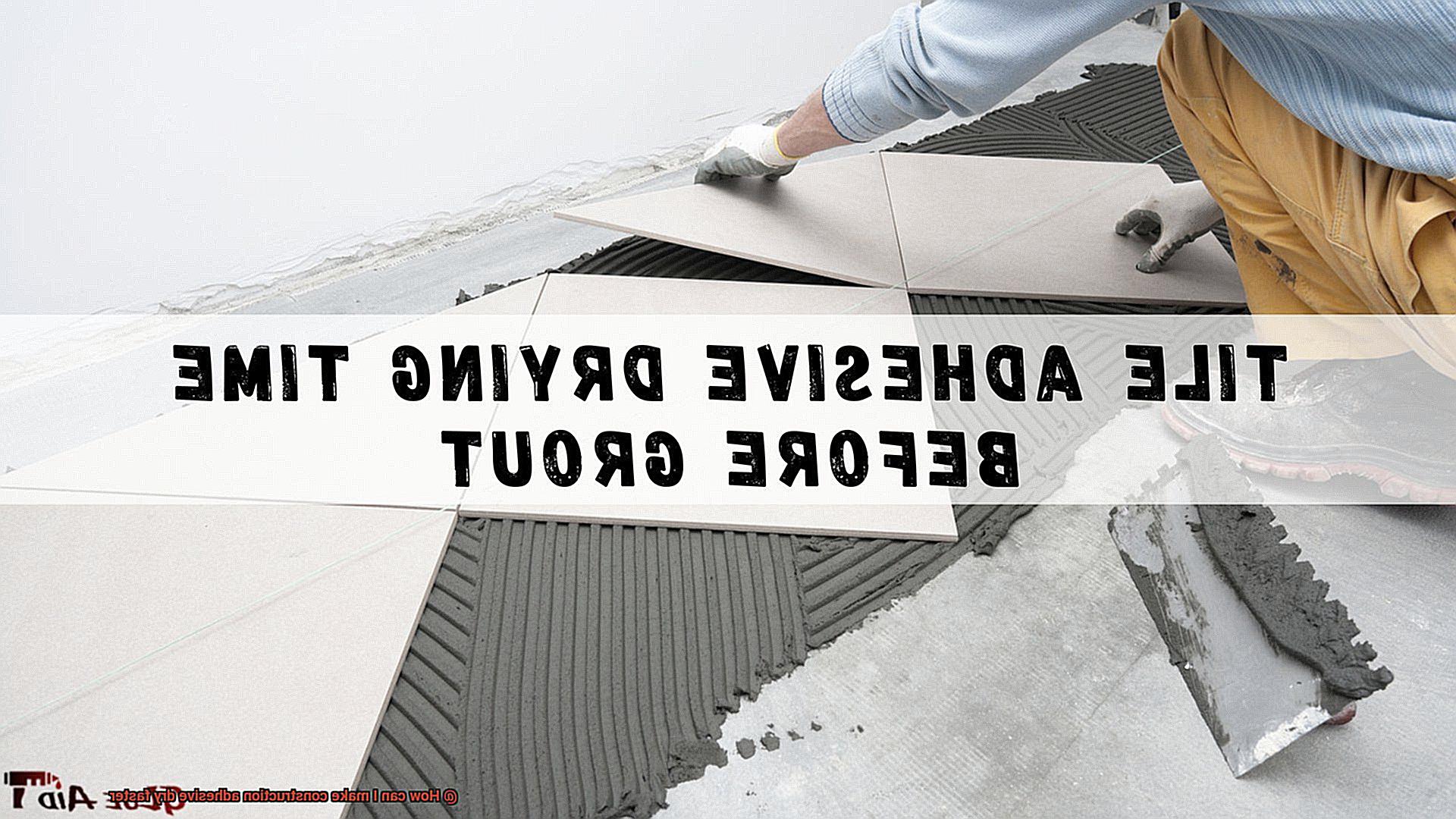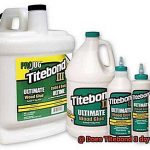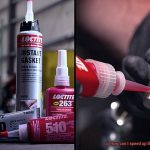Waiting for construction adhesive to dry can be frustrating, especially when you’re on a tight schedule. But don’t worry, because in this blog post, we’re going to dive into the world of construction adhesive and uncover some amazing tricks to make it dry faster.
Construction adhesive is a super versatile and essential adhesive that’s used in all sorts of construction projects. It’s perfect for bonding materials like wood, metal, concrete, and drywall. This tough adhesive creates a bond that can handle extreme temperatures, vibrations, and changes in humidity.
But here’s the thing: the drying time of construction adhesive can be a real pain, especially if you’ve got a lot on your plate or multiple projects lined up. The good news is that there are some awesome techniques you can use to speed up the drying process. These tips will not only save you time but also ensure a strong and reliable bond.
In this blog post, we’ll spill the beans on these valuable tricks. We’ll talk about using accelerators, getting proper ventilation, controlling the temperature, and prepping the surface. By following these methods, you’ll be able to make your construction adhesive dry faster without sacrificing quality.
So if you’re eager to save time and get your construction projects done quickly and efficiently, keep reading. We’re about to reveal all the secrets of making construction adhesive dry faster. Get ready to tackle your projects with confidence.
What is Construction Adhesive?
Contents
- 1 What is Construction Adhesive?
- 2 Factors that Affect Drying Time
- 3 Increasing Temperature to Accelerate Drying
- 4 Reducing Humidity for Faster Drying
- 5 Follow Manufacturer’s Instructions and Guidelines
- 6 Choosing an Adhesive with a Faster Drying Time
- 7 Benefits of Quick-Dry Construction Adhesives
- 8 Conclusion
In the world of construction and DIY projects, having a reliable adhesive is crucial for creating strong and durable bonds. That’s where construction adhesive comes in. This powerful adhesive, also known as construction glue or construction sealant, is designed specifically to provide a permanent bond between various materials such as wood, metal, concrete, ceramic, and plastic. In this article, we’ll explore the versatility and benefits of construction adhesive, as well as how it can be used to tackle a wide range of projects.
Versatility:
Construction adhesive is a true multitasker. It can be used in a variety of applications, including but not limited to:
- Installing subfloors and drywall panels
- Bonding trim and molding
- Repairing loose tiles or bricks
- Securing countertops and cabinets
- Assembling furniture or cabinetry
Strength and Durability:
One of the key advantages of construction adhesive is its ability to create long-lasting bonds that can withstand heavy loads, vibrations, and extreme weather conditions. Unlike traditional fasteners like nails or screws that may weaken over time, construction adhesive forms a strong bond that ensures structural integrity for years to come.
Ease of Application:
Construction adhesive is typically available in tubes or cartridges that can be easily dispensed using a caulking gun or squeeze tube. The adhesive is applied in a bead or line onto the surface, depending on the specific project requirements. Its viscous consistency allows for easy application and ensures even distribution for maximum bond strength.
Drying and Curing Time:
After application, construction adhesive requires time to dry and cure before reaching its maximum strength. The drying time can vary depending on factors such as temperature, humidity, and the type of adhesive used. It is important to follow the manufacturer’s instructions regarding recommended drying times to ensure optimal bond performance.
Considerations for Faster Drying:
If you’re working on a time-sensitive project, there are a few techniques you can employ to expedite the drying process of construction adhesive:
- Increasing the temperature in the workspace can accelerate the chemical reaction that causes the adhesive to dry and cure. However, be cautious not to overheat or damage the materials being bonded.
- Reducing humidity levels using dehumidifiers or air conditioning units can also help speed up drying times.
- Choosing quick-drying adhesives specifically formulated for time-sensitive projects is another option. These adhesives have shorter curing times compared to regular options, allowing you to finish your projects faster.
Factors that Affect Drying Time
Construction adhesive is a versatile product widely used across industries, but waiting for it to dry can be frustrating. In this article, we will explore the factors that affect drying time and provide valuable insights to expedite the process.
Temperature:
Temperature plays a crucial role in drying time. Higher temperatures accelerate solvent evaporation, leading to faster drying. Lower temperatures significantly slow down the process. Working within the recommended temperature range ensures optimal bonding and faster drying.
Humidity:
Humidity levels impact drying time. High humidity hinders solvent evaporation, prolonging drying. Low humidity facilitates quicker evaporation and faster drying. Working in a well-ventilated area with controlled humidity optimizes drying time.
Substrate Type:
The type of surface affects drying time. Porous surfaces like wood or concrete absorb moisture from the adhesive, slowing drying time. Non-porous surfaces like metal or glass allow for faster solvent evaporation and quicker drying.
Application Thickness:
The thickness of the adhesive layer influences drying time. Thicker layers take longer to dry as more material needs to evaporate or cure. Following manufacturer guidelines for application thickness ensures optimal drying.
Adhesive Type:
Different adhesives have varying drying times. Some are designed for quick bonding and drying, while others require longer drying for heavy-duty applications. Choosing the appropriate adhesive for specific project requirements is essential for desired drying time.
Increasing Temperature to Accelerate Drying
When it comes to construction projects, waiting for adhesive to dry can feel like watching paint dry – a slow and tedious process. However, there’s a secret weapon that can expedite drying time and allow you to complete your projects faster: increasing the temperature. In this article, we will explore the benefits of temperature and provide practical methods to accelerate the drying process of construction adhesive.
Understanding Adhesive Types:
Before unleashing the power of temperature, it’s crucial to understand the specific type of construction adhesive you’re working with. Different adhesives have varying temperature tolerances, so consulting the manufacturer’s guidelines or product specifications is essential. Ignoring this step could compromise the integrity of your project and lead to disappointing results.
Effects on Drying Time:
Increasing the temperature activates the adhesive molecules, speeding up the evaporation of solvents or water content within the adhesive. This rapid evaporation results in a shorter drying time, allowing you to move forward with your project more quickly.
However, it’s vital to strike a balance between speed and bond strength because higher temperatures can sometimes hinder full curing and compromise the adhesive’s optimal strength.
Methods for Faster Drying:
- Targeted Heat Application: Employing heat lamps or heat guns enables you to apply heat directly and precisely to the adhesive. This method is particularly effective for smaller areas or when working with limited amounts of adhesive.
- Creating a Warm Environment: Maintaining a consistently warm climate using space heaters or adjusting room temperature promotes faster drying throughout the entire application area. However, ensure proper ventilation to prevent potential health hazards associated with increased temperatures and fumes.
Risks of Using the Wrong Adhesive:
Using an inappropriate adhesive for your application can lead to disastrous consequences. The wrong adhesive may not withstand environmental conditions or adhere properly to materials, resulting in weakened bonds, structural failures, and costly repairs. Always choose an adhesive designed for the specific substrates and conditions of your project to ensure optimal performance and longevity.
Reducing Humidity for Faster Drying
I have the solutions to make the drying process go by in a flash. One of the key culprits that can slow down drying time is none other than high humidity. That pesky moisture in the air prevents the adhesive from evaporating and setting properly. But fret not, for I have a bag full of tricks to reduce humidity and speed up the drying process.
First and foremost, consider unleashing the power of a dehumidifier in the area where the adhesive is being applied. This nifty device is like having your own personal humidity superhero. It sucks out excess moisture from the air, creating a drier environment that is more conducive to quick drying. Say goodbye to humidity and hello to speed.

Another method to reduce humidity is to crank up the ventilation. Throw open those windows or fire up some fans to get that air circulating. By doing so, you lower humidity levels and create an environment where moisture can escape. The adhesive will thank you as it dries faster than ever before.
Now, reducing humidity is just one piece of the puzzle. Temperature and surface conditions also play a crucial role in drying time. Aim for a moderate and consistent temperature that won’t leave your adhesive feeling either too hot or too cold. Extremes are not its friends. And let’s not forget about cleanliness. Make sure the surface where the adhesive is applied is squeaky clean and bone dry before slapping on that glue. Moisture and debris are not welcome here; they only prolong drying time.
Of course, it’s important to consult the manufacturer’s instructions for the specific construction adhesive you’re using. Each adhesive has its own quirks and requirements, so don’t skip this step if you want optimal results. Following the guidelines will ensure you’re on the right track to speedy drying.
Feeling ambitious? Well, why not try adding a specialized accelerator or drying agent recommended by the manufacturer? These magical potions are designed to turbocharge the curing process and may be just what you need for a lightning-fast adhesive bond.
But remember, my friends, patience is key. Don’t go rushing the drying process by applying excessive heat or force. You don’t want to compromise the integrity of the bond. Allow sufficient time for the adhesive to fully cure and set before subjecting it to any stress or load. Rome wasn’t built in a day, and neither should your projects be rushed.
Follow Manufacturer’s Instructions and Guidelines
Construction adhesive is a powerful tool that can make or break your project. To ensure success, it is essential to follow the manufacturer’s instructions and guidelines. These seemingly mundane details hold the key to unlocking the adhesive’s full potential and guaranteeing a strong, reliable bond. Ignoring these instructions is like trying to solve a puzzle without the picture on the box – you may end up with a jumbled mess.
Let’s delve into why it is so crucial to heed the manufacturer’s advice:
- Drying Time: Patience is a virtue, especially when it comes to construction adhesive. Rushing the drying process can result in a lackluster bond and weak adhesion. By adhering to the recommended drying time, you give the adhesive the opportunity to fully dry and cure, creating an unbreakable connection.
- Application Thickness: Just like delicately spreading frosting on a cake, applying the right amount of adhesive is crucial. Too much adhesive can lead to excessive drying time, while too little can compromise the bond’s strength. Following the manufacturer’s guidelines ensures that your adhesive dries efficiently while maintaining its structural integrity.
- Temperature and Humidity: Adhesives are finicky creatures when it comes to their environment. They thrive under specific conditions for application and drying. So, pay attention to temperature recommendations – extreme heat or cold can wreak havoc on the drying time and overall performance of the adhesive. Remember, humidity also plays a role, as it can slow down or speed up drying depending on the adhesive type.
- Safety First: Your well-being matters. Some construction adhesives contain volatile chemicals that require proper ventilation or protective gear during application and drying. By following these safety guidelines, you not only protect yourself but also help the adhesive dry faster. It’s a win-win.
Choosing an Adhesive with a Faster Drying Time
If so, then choosing an adhesive with a faster drying time is the answer to all your problems. But how do you go about selecting the perfect adhesive for your needs? Let’s dive into the various factors to consider when choosing an adhesive with a faster drying time.
First and foremost, the type of adhesive plays a crucial role in determining its drying time. Different adhesives have different drying times, so it’s essential to select one that is specifically designed for quick drying. Check out these options:
- Cyanoacrylate Adhesive (Super Glue): This adhesive is renowned for its lightning-fast bonding capabilities, making it perfect for projects that require immediate results. Just be sure to check the manufacturer’s guidelines to ensure compatibility with your materials.
- Fast-Drying Epoxy Adhesive: While epoxy adhesives typically have a longer drying time, there are fast-drying variants available in the market. These adhesives usually come in two parts – a resin and a hardener – that need to be mixed together before application. By using a heat source like a heat gun or a hairdryer, you can accelerate the curing process and achieve faster drying times.
- Construction Adhesives formulated for Quick Drying: Some construction adhesives are specifically formulated for rapid drying. These adhesives often contain additives or accelerators that speed up the curing process. Check the product labels or consult with an expert at your local hardware store to find adhesives designed for quick drying.
While selecting an adhesive with a faster drying time can be advantageous, it’s crucial to follow the manufacturer’s instructions and guidelines for proper application and curing. Rushing the drying process or using excessive amounts of adhesive can lead to weak bonds or other issues. So take your time and apply the adhesive correctly for the best results.
Benefits of Quick-Dry Construction Adhesives
Well, the solution is simple: choose an adhesive with a need-for-speed mentality. Quick-dry construction adhesives offer several benefits that can make your projects faster and more efficient.
First and foremost, quick-dry construction adhesives save you time. Traditional adhesives can take hours or even days to fully dry and cure, which can really slow down your progress. But with quick-dry adhesives, the drying time is greatly reduced. It’s like strapping a rocket to your adhesive, propelling you forward and allowing you to move on to the next step of your project sooner. This not only saves time but also increases overall productivity.
Versatility is another major advantage of quick-dry construction adhesives. These adhesives are like chameleons in a hardware store. They can be used on a wide range of materials, including wood, metal, plastic, and ceramics. This means you can use a single adhesive for multiple purposes, simplifying the construction process and reducing the need for multiple products. It’s like having a Swiss Army knife in your toolbox.
Despite their fast drying time, quick-dry adhesives offer bonds that are stronger than Hercules himself. They can withstand heavy loads and various weather conditions, ensuring that the bonded surfaces remain secure and stable over time. It’s like having an adhesive superhero by your side, protecting your projects from any villainous threats.
One of the best things about quick-dry construction adhesives is their low odor. Strong odors from traditional adhesives can be unpleasant or even harmful when working in confined spaces or indoor environments. But quick-dry adhesives with low odor make the construction process more comfortable and user-friendly. It’s like a breath of fresh air in a room filled with noxious fumes.
Lastly, many quick-dry construction adhesives are like submarines in a sea of moisture. They’re water-resistant or waterproof once fully cured. This makes them suitable for both indoor and outdoor applications, as they can withstand exposure to moisture without compromising their bonding strength. So whether you’re working in a bathroom or an outdoor project, these adhesives have got you covered. It’s like having an adhesive that can swim with dolphins.
Conclusion
In conclusion, waiting for construction adhesive to dry can be a maddening experience, especially when time is of the essence. But fear not, there are techniques you can employ to expedite the drying process without compromising the strength of the bond.
First and foremost, it’s crucial to understand the variables that influence drying time: temperature, humidity, substrate type, application thickness, and adhesive formulation. By taking control of these factors, you can optimize the drying time of your construction adhesive.
Ramp up the heat in your workspace to kickstart the chemical reaction that triggers drying and curing. However, exercise caution not to scorch or harm the materials you’re bonding together.
Banish excess moisture by employing dehumidifiers or air conditioning units. These devices will help whisk away humidity and hasten drying times. Additionally, consider investing in quick-drying adhesives specifically designed for time-sensitive projects – they can work wonders in slashing drying time.
Remember: always adhere (pun intended) to the manufacturer’s instructions and guidelines for proper application and curing. Rushing through the drying process or slathering on excessive amounts of adhesive may result in feeble bonds or other complications.
By arming yourself with these tips and tricks, you’ll be able to make your construction adhesive dry faster while maintaining top-notch quality.






